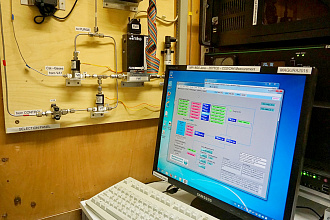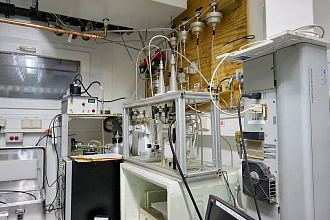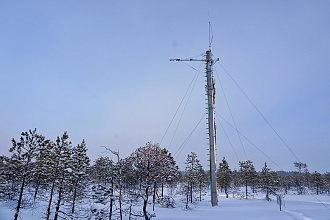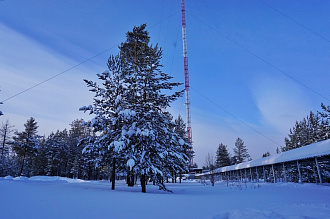The ZOTTO International Observatory has become a catalyst for the creation of a unique regional network for monitoring greenhouse gases in the Krasnoyarsk Region
11 June 2021 г.

Candidate of Biological Sciences, Scientific Coordinator of the ZOTTO Observatory and Senior Researcher at the Institute of Forest SB RAS Alexey Panov told about the main tasks of the ZOTTO observatory, amount and sources of funding, and plans of scientists concerning its use.
Could you briefly describe the backstory and scientific objectives of the ZOTTO observatory?
For almost 15 years in Siberia, the staff of the V.N. Sukachev Institute of Forest SB RAS, together with a number of other academic institutes and universities, and the Max Planck Scientific Society (Germany) has carried out year-round high-precision studies of the composition of greenhouse gases and atmospheric aerosols using a unique set of scientific equipment based on the 300-meter mast of the ZOTTO observatory. The station began to be installed in 2003 in the north of the Krasnoyarsk Region near the village Zotino. Samples at all heights, from the lower layer at 4 meters to the upper level of 301 meters, started to be taken after the completion of the construction in autumn of 2006.
This height allows one to explore a relatively homogeneous part of the atmosphere - the boundary layer. This makes it possible to estimate the surface flows of greenhouse gases averaged over the vast area of Siberia (> 2.5 million sq km). Terrestrial ecosystems of Siberia as natural absorbers of atmospheric carbon have hardly been studied. Therefore, long-term observations of changes in the concentration of greenhouse gases in combination with local estimates of absorption and release of carbon into the atmosphere by individual ecosystems are necessary for model calculations of the carbon balance, both on a regional and global scale.
What are the costs of annual maintenance of the ZOTTO observatory in working order, what do they include and how are these costs funded?
What are the sources and format for financing such "atypical" work with a large infrastructural component and long time for collecting and processing information? After all, monitoring, and in this case it concerns long-term climatic variables, does not give a quick outcome in the form of monthly, and maybe even annual, intermediate results.
Until 2014, the Russian government annually allocated relatively small money, about 1 million roubles, for the maintenance of the observatory, but these were targeted funds from the SB RAS budget. After the restructuring of the Russian Academy of Sciences, the internal academic program to support hospitals and observatories ceased to exist. There is currently no analog of this program, neither is there any targeted long-term support of scientific infrastructure facilities. It is worth noting that since 2020, a number of competitions have been launched by the Ministry of Education to support research on the basis of collective use centers and unique scientific installations (UNI). The ZOTTO observatory is included in the UNI list, but the special character of its work makes it almost impossible to participate in this competition. The requirements for publication activity are not applicable for long-term monitoring studies, since the last launched competition assumes that at least 27 articles will be published in the first and second quartile journals indexed in WoS or Scopus in three years.
On the other hand, the suggested amount of funding for this program, up to 100 million roubles per year for three years, is excessive for ZOTTO. These funds would be enough for 20 years of continuous monitoring studies at the observatory. Undoubtedly, such programs are important and extremely promising for breakthrough research, but monitoring studies are valuable for their duration, when data series are becoming increasingly important in the eyes of the scientific community every year. The ZOTTO observatory was created with the aim of serving world science for 30 years or more, and it is not just a unique scientific object, but also a testing ground for international interdisciplinary research.
What are the short and long term plans for the observatory?
The observatory is only a part of the regional network for monitoring greenhouse gases "KrasFLUX" created by specialists of the Institute of Forest SB RAS, one of the institutes of the Federal Research Center "KSC SB RAS", in the ecosystems of the key bioclimatic areas of the Yenisei River basin - boreal forests and forest tundra, mostly located on the permafrost. In addition to ZOTTO, the monitoring network includes an atmospheric observatory at the confluence of the Yenisei into the Kara Sea, which expands the coverage of the ZOTTO observatory and makes it possible to assess the transport of greenhouse gases in the Arctic Ocean, and five stations for measuring carbon fluxes in the ecosystems: forest-tundra (Igarka city), northern taiga larch forest (Tura village, Evenkiysky EP IF SB RAS); and high bog, pine forest and dark coniferous taiga of the middle taiga subzone of Siberia (Zotino village, ZOTTO observatory). In general, the monitoring network estimates the ability of ecosystems to absorb carbon at the level of the entire region under study, namely, the Yenisei River basin and its key biogeocenoses.
Is it possible to single out several main results, already published or presented in reports, which have been obtained from the very start of the observatory establishment?
Much has already been done, most of the results have been published in highly rated scientific journals. In the course of many years of research, it has been found, in particular, that in the background natural and climatic conditions of Siberia, there is an annual increase in the concentration of CO2 (~ 2 ppm / year) and methane (~ 9 ppb / year). Nevertheless, the analysis of the exchange fluxes of carbon dioxide between Siberian terrestrial ecosystems and the atmosphere indicates that all of them, as a rule, act as absorbers of atmospheric CO2, but the amount of absorbed carbon dioxide varies greatly from year to year. This is especially typical for northern ecosystems in the permafrost zone, where there is also a significant release of methane. Continued research is extremely necessary to understand the causes of interannual variability in atmospheric deposition of CO2 and methane release in natural ecosystems, and, accordingly, to predict their response to ongoing climate and environmental changes.
What is the value of such work in the light of the current discussions about decarbonization of the economy, global warming, and carbon polygons?
The scientific platform in the form of a regional network for monitoring greenhouse gases is a unique infrastructure created in the Krasnoyarsk Region by scientists from the Federal Research Center "KSC SB RAS" in close cooperation with colleagues from other organizations. It should be involved in the implementation of the program for the creation of carbon polygons in the Russian Federation. No other region in Russia has such a large-scale and ready-made scientific infrastructure for studying greenhouse gas flows. It is important that it does not need to be created from nothing, but only needs to be maintained.
It should be noted that the entire instrumental base of the instrumental monitoring network is certified by the World Meteorological Organization (WMO), and the measurement regulations comply with international standards. This means that the resulting carbon sequestration units will be recognized by the EU and other countries, which are parties to climate agreements. Unfortunately, the Krasnoyarsk Region was not included in the pilot project for the creation of carbon polygons in the regions of Russia; at present, there are seven such regions. However, we are working to include ZOTTO and the entire KrasFLUX monitoring network into the carbon polygon program at the next stage of the project implementation.
Share:






